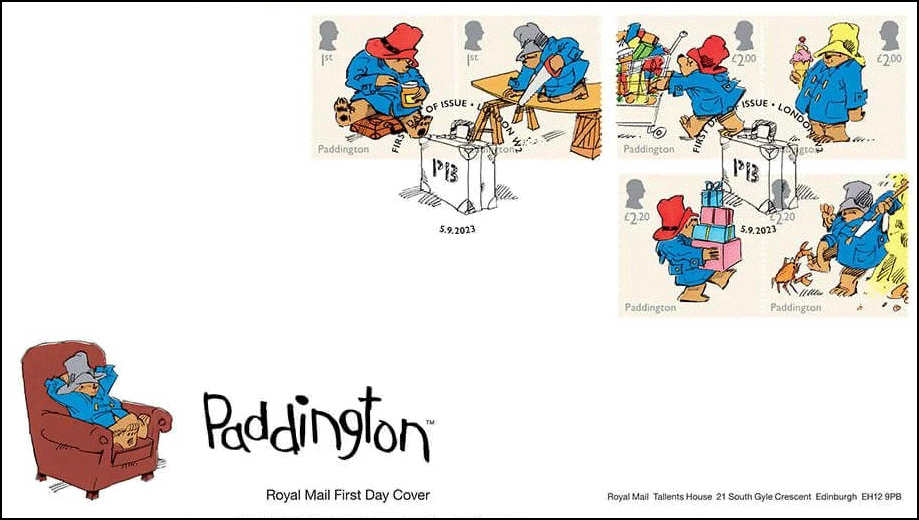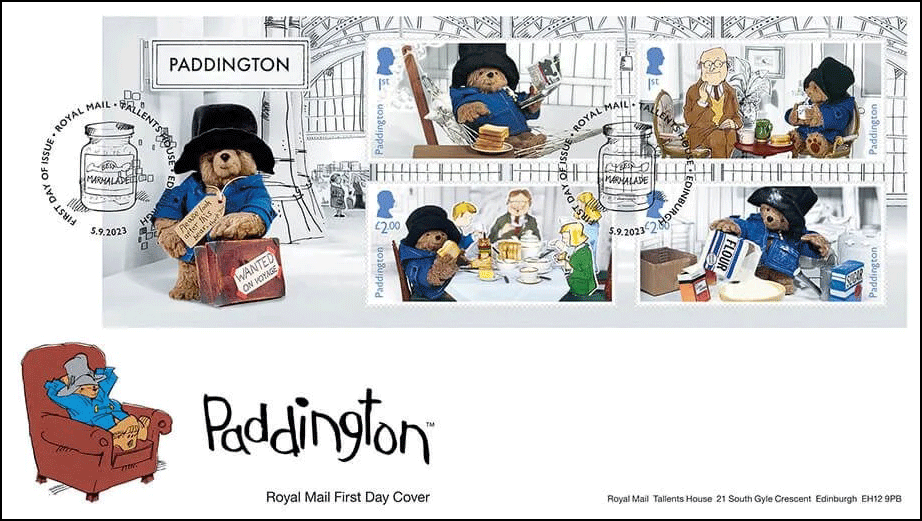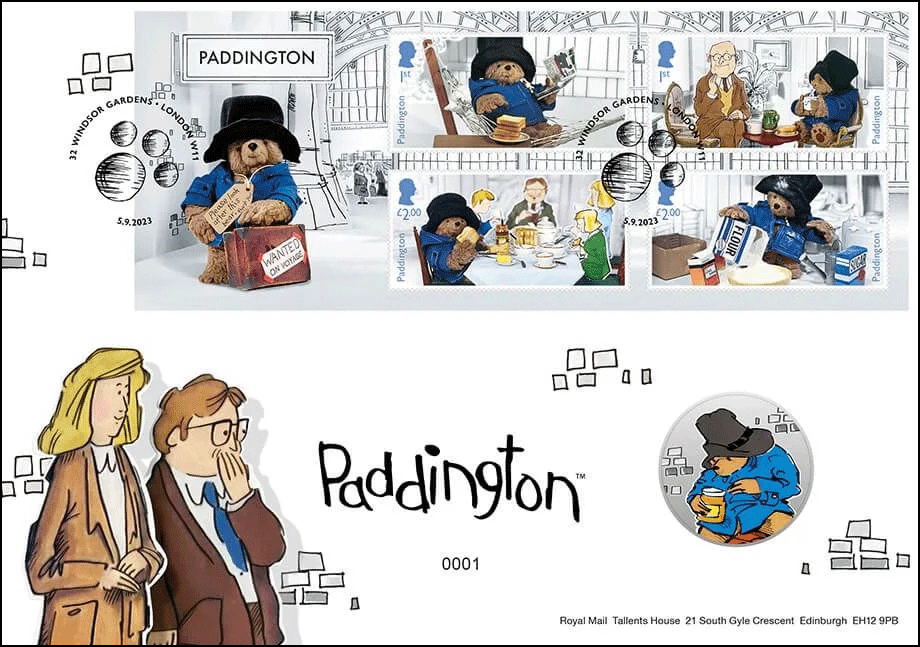Now available:
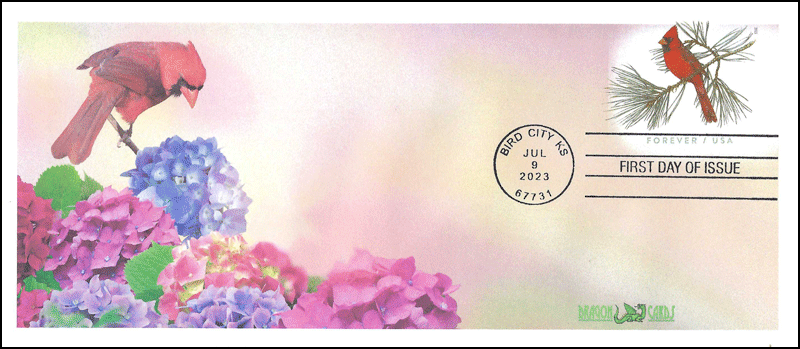
Dgn 810b $3.00
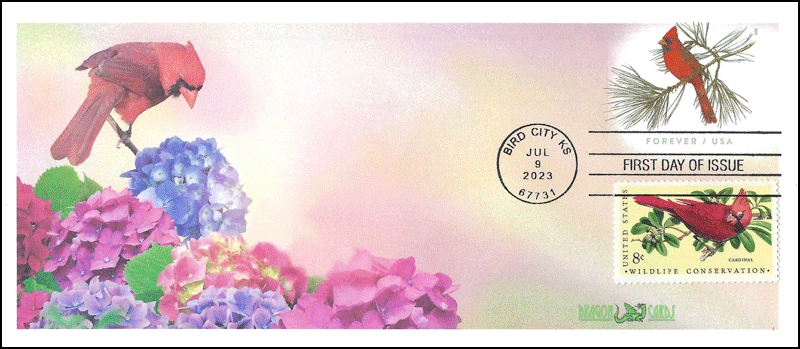
Dgn 810c $3.50
You can see these and more on the Dragon Cards Web site.

Now available:


From the National Park Service and ESPER:
On Tuesday, September 19, 2023, at 11 A.M. at the African Burial Ground National Monument,  290 Broadway, New York, New York, the U.S. National Park Service in collaboration with The Black Women’s Leadership Caucus, Inc. will host a Special Dedication and Unveiling of the Forever U.S. Postage Stamp of The Honorable Congressman John A. Lewis. The stamp celebrates the life and legacy of Congressman Lewis who spent more than 30 years in Congress and a lifetime defending our democracy – our civil rights.
290 Broadway, New York, New York, the U.S. National Park Service in collaboration with The Black Women’s Leadership Caucus, Inc. will host a Special Dedication and Unveiling of the Forever U.S. Postage Stamp of The Honorable Congressman John A. Lewis. The stamp celebrates the life and legacy of Congressman Lewis who spent more than 30 years in Congress and a lifetime defending our democracy – our civil rights.
The Rev. Al Sharpton is our keynote speaker. The program includes the U.S. Postal Service Color Guard, a member of the Metropolitan Opera, an aspiring  spoken word artist and gift bags to the first 50 guests. Stamps and other John Lewis memorabilia will be available for purchase.
spoken word artist and gift bags to the first 50 guests. Stamps and other John Lewis memorabilia will be available for purchase.
The event is free and open to the public, and no reservation is required. However, “Security at 290 Broadway is airport-like; travel light, no large bags,” says the National Park Service.
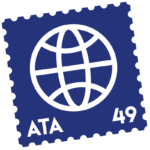 The question was posed in the American Topical Association’s Facebook group about a favorites sports/philatelic memory. This is mine:
The question was posed in the American Topical Association’s Facebook group about a favorites sports/philatelic memory. This is mine:
In 1979, I was a freelance radio sports reporter, covering the Baltimore Orioles, who won the American League Pennant and went to the baseball World Series. I discovered the Baltimore post office had a station in Memorial Stadium with a pictorial postmark, and purchased a stamp and had it serviced. (Appropriately, the stamp is the Fort McHenry Flag, and Fort McHenry is in Baltimore Harbor.)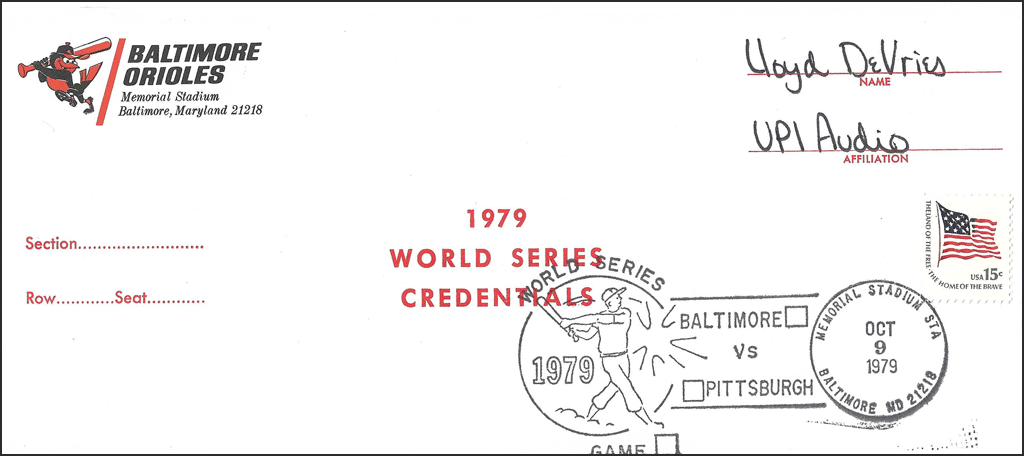
Now, freelance reporters don’t travel with teams, except on rare occasions or at their own expense. I did not go to Pittsburgh for Games 3, 4 and 5, but when the Series came back to Baltimore, I was ready: I obtained a few more credentials envelopes from my friends in the public relations office and had topically-related stamps ready, to produce another cover.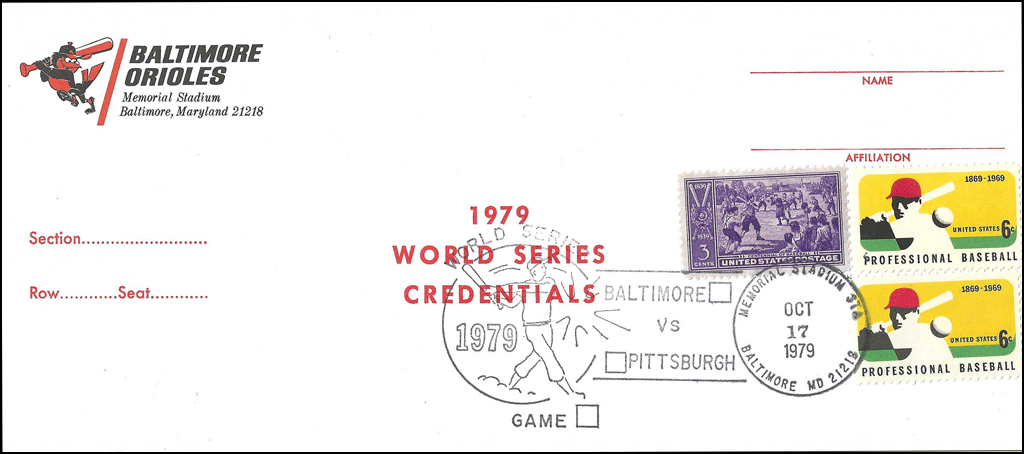
I also obtained a few Baltimore Orioles No. 10 business envelopes.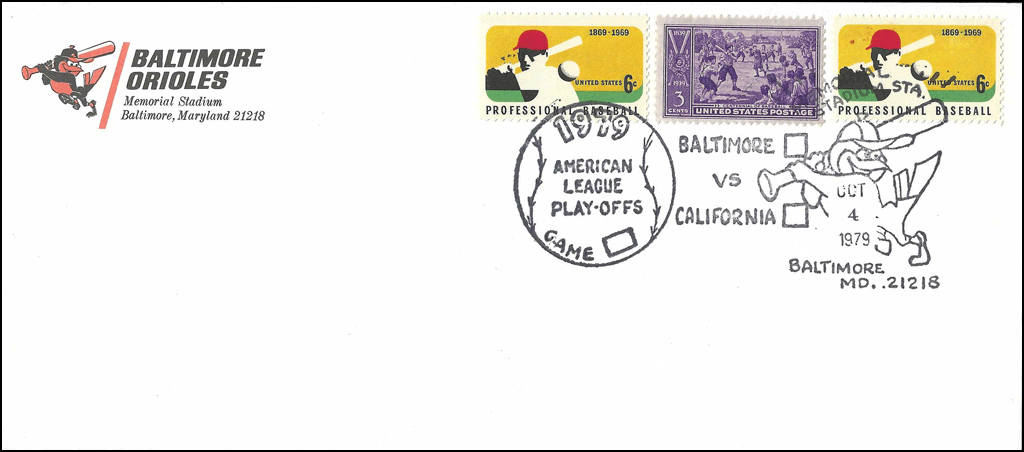
Sidebar: UPI Audio sent its White House reporter Tom Foty, who is still working in 2023 for CBS News, Radio, on weekends, to do the reports during the American League Championship Series. UPI’s competitor, AP Radio, asked me to do its voicework during the ALCS — but UPI wouldn’t let me use my own name! “‘Lloyd  de Vries’ belongs to us!”
de Vries’ belongs to us!”
I was doing two reports an hour for APR as “Dave Archer” (“Archer” is my middle name, “Dave” was a corruption of one of the many mispronunciations of “de Vries”), one an hour for Canadian Broadcasting Corp. Radio as “Lloyd de Vries,” and various stations and regional networks at different points, also under my own name. We secondary press were displaced from the press box and put in the stands, where I had had my own telephone installed, and I had cards in front of me to make sure I got the names, times, and everything else right.
I used to hang out at the office in Washington with the APR guys, though, so every time “Dave Archer” called in, we all started laughing. “OK, Dave or Lloyd or whatever your name is….”
 Sadly, the O’s lost to the Pittsburgh Pirates in 7 games. And to this day, I cannot stand to hear the Bucs’ anthem, “We Are Family,” which was played ad nauseam by Pittsburgh. Still, this is my favorite memory combining sports and philately, and maybe even combining my career and philately.
Sadly, the O’s lost to the Pittsburgh Pirates in 7 games. And to this day, I cannot stand to hear the Bucs’ anthem, “We Are Family,” which was played ad nauseam by Pittsburgh. Still, this is my favorite memory combining sports and philately, and maybe even combining my career and philately.
[press release] [click on any of the pictures for larger versions]
Royal Mail to Honour Dame Shirley Bassey with a Set of 12 Special Stamps
 Royal Mail has revealed images of 12 Special Stamps being issued to celebrate the musical icon Dame Shirley Bassey, 70 years on from the start of her career in 1953.
Royal Mail has revealed images of 12 Special Stamps being issued to celebrate the musical icon Dame Shirley Bassey, 70 years on from the start of her career in 1953.
This is the first time Royal Mail has dedicated an entire stamp issue to a solo female music artist. Solo artists previously honoured with a dedicated stamp issue are: David Bowie (2017); Sir Elton John (2019); and Sir Paul McCartney (2021).
Eight stamps in the main set capture some of her spellbinding performances from her illustrious career:
An additional sheet of four stamps features a beautiful selection of candid photographs taken of Dame Shirley during recording sessions and rehearsal sessions during her career.
Born in 1937 in Tiger Bay, Cardiff, Dame Shirley toured theatres and revues until she signed a record deal with Philips and scored the number one hit, ‘As I Love You’, in 1959. By the 1960s, she was an international star with numerous hit albums spanning contemporary pop, show tunes and soundtracks. Some of her greatest work was with film composer John Barry, creating the James Bond themes ‘Goldfinger’, Diamonds Are Forever’ and ‘Moonraker’, which became her signature songs.
In the 1990s and 2000s, she attracted a whole new audience, performing the official song for the 1999 Rugby World Cup with Bryn Terfel and attending the 2007 Glastonbury Festival in diamante wellington boots. She was awarded a CBE in 1994 and a DBE in 1999.
Dame Shirley Bassey said: “I am absolutely thrilled and would never have dreamed that one day my face would be on a stamp…that one day a letter might arrive and there I am, with a postmark next to me!
“It’s an absolute honour to be the first solo female artist to receive a collection from Royal Mail. The stamps are wonderful, and I hope my fans & collectors love them as much as I do.”
David Gold, Director of External Affairs and Policy said: “For seven decades Dame Shirley Bassey has captivated fans across the world with her distinctive and powerful voice. This stamp issue is a fitting celebration of one of the UK’s most revered and longest serving musical icons.”
The stamps are available to pre-order from now at www.royalmail.com/shirleybassey and by telephone on 03457 641 641. A Presentation Pack including all 12 stamps in the set is priced at £19.50. The stamps go on general sale on 21 September.
 [VSC Notes: Bassey is now 86. The Royal Mint issued a commemorative coin in her honour earlier this year. See the photo. In addition to the stamps, other philatelic products include framed stamps signed in gold ink by Bassey herself (£249.99); various coin covers ranging from £19.99 to £750.00; a collector’s sheet, a fan sheet; first day covers; a press sheet; postcards; and various stamp sheet configurations of just the first-class stamps and just the £2 ones.]
[VSC Notes: Bassey is now 86. The Royal Mint issued a commemorative coin in her honour earlier this year. See the photo. In addition to the stamps, other philatelic products include framed stamps signed in gold ink by Bassey herself (£249.99); various coin covers ranging from £19.99 to £750.00; a collector’s sheet, a fan sheet; first day covers; a press sheet; postcards; and various stamp sheet configurations of just the first-class stamps and just the £2 ones.]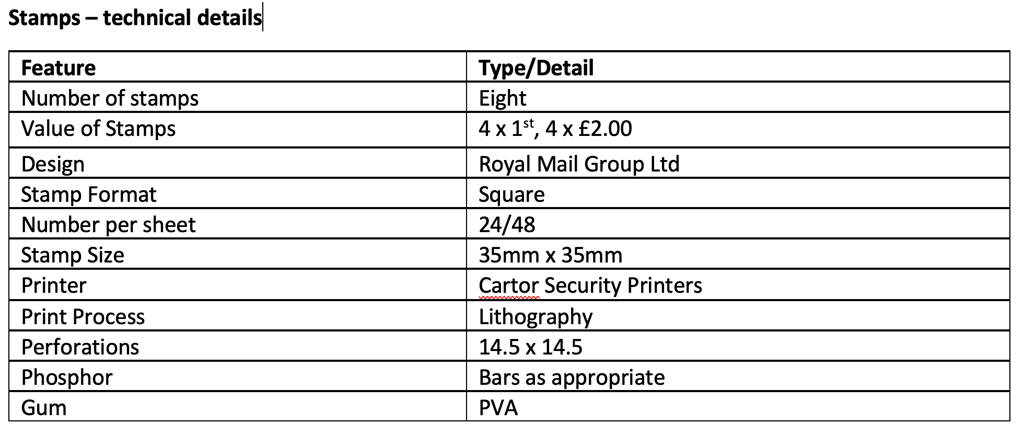
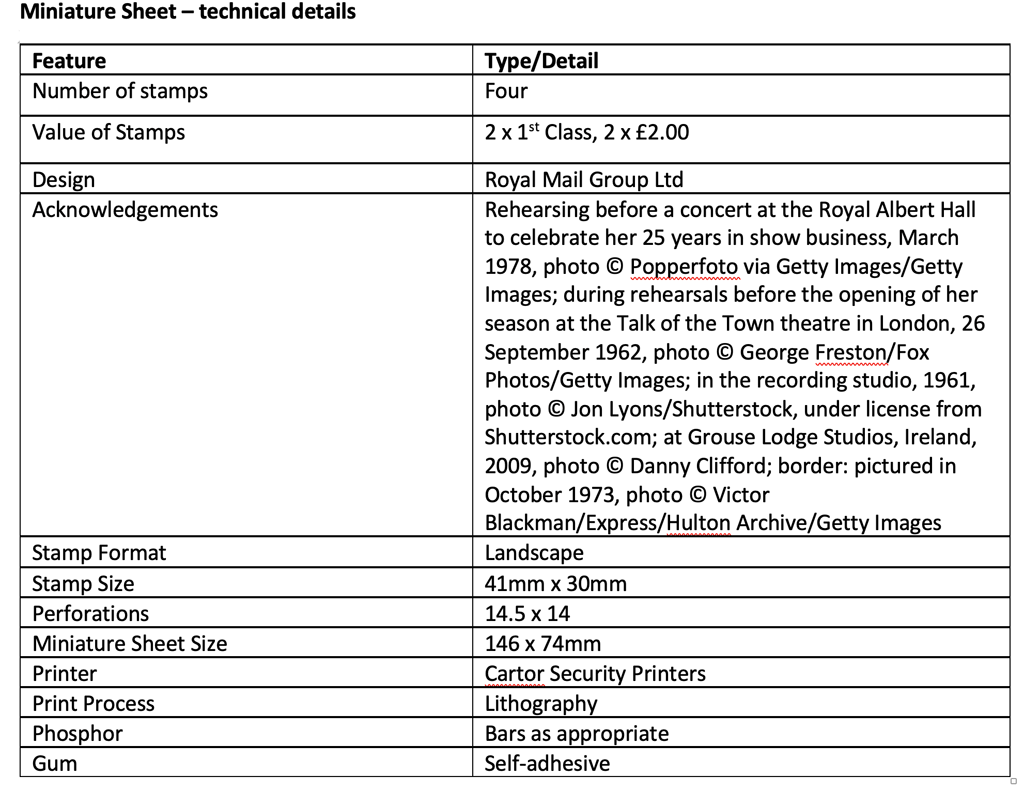 Videos:
Videos:
Shirley Bassey singing “Goldfinger” in 1965:
Shirley Bassey singing “Goldfinger” in 2011:
Artificial Intelligence? I think the phenomenon is not only very much overblown and it is also not new. What is new is the “Everybody Knows” fear-mongering that AI is taking over.
All computers can do is choose fro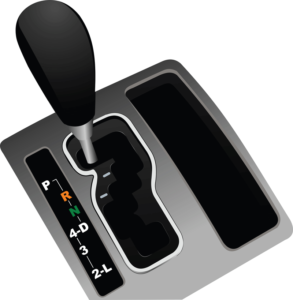 m among the choices a human or group of humans have provided. They may do so more quickly, sorting and choosing from a large number of options, but they don’t create, except under our direction.
m among the choices a human or group of humans have provided. They may do so more quickly, sorting and choosing from a large number of options, but they don’t create, except under our direction.
Two quick examples: Does your car have an automatic transmission? It switches gears so the vehicle can speed up or slow down, climb hills or descend. You could do it yourself but possibly not as quickly or as smoothy. I think that’s an example of “artificial intelligence,” but it’s not new. Automatics began to appear in mass-produced automobiles in 1939.
How many minutes has it been since you cursed out the spellchecker on y our phone or computer? These programs think they know what you meant to write or should have written and change your text, often resulting in embarrassment or gibberish.
our phone or computer? These programs think they know what you meant to write or should have written and change your text, often resulting in embarrassment or gibberish.
Can AI create artwork of a pastoral day in the country? Yes, if someone programmed it that the sky should be blue, the grass and other vegetation green, and so on. Can it write text? Again, yes, if someone programmed it properly. Otherwise you might end up with a sterling endorsement, like the one that runs regularly on my Kindle: “Try to enjoy reading the poems.” Sorry, if I have to try to enjoy reading something that is for recreation, I’m going to skip it.
When “AI” beats you at chess, that isn’t artificial intelligence, it is good programming: Someone put in all the possible moves for all situations and the chances that the human 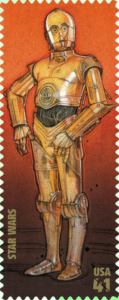 opponent would do such-and-such as a result of a given move. College papers written by AI? Most professors probably would welcome the improvement! And what’s the difference between a heavily “photo-shopped” photograph and one created from scratch using an AI program? Where is the line?
opponent would do such-and-such as a result of a given move. College papers written by AI? Most professors probably would welcome the improvement! And what’s the difference between a heavily “photo-shopped” photograph and one created from scratch using an AI program? Where is the line?
One of my favorite Science Fiction authors, Glynn Stewart, writes about what he calls “artificial stupids:” Robots or holograms that make choices within severely limited parameters. I don’t think we have progressed beyond that: Humans set up the choices, even for sophisticated AI programs. I don’t see that changing any time soon.
 5801 (66¢) John Lewis
5801 (66¢) John Lewis
a. Imperforate
5802 Life Magnified pane of 20
a. (66¢) Red blood cells
b. (66¢) Macaw parrot feather
c. (66¢) Human hair
d. (66¢) Moss leaves
e. (66¢) Arranged diatoms
f. (66¢) Freshwater protozoans
 g. (66¢) Acorn barnacle
g. (66¢) Acorn barnacle
h. (66¢) Moth antenna
i. (66¢) Diving beetle front foot
j. (66¢) Mouse brain neurons
k. (66¢) Starling bone tissue
l. (66¢) Moth wing scales
m. (66¢) Zebrafish
n. (66¢) Mushroom gills
o. (66¢) Freshwater snail tongue
p. (66¢) Blue button organism
q. (66¢) Mold spores
r. (66¢) Barnacle legs
![]() s. (66¢) Flame lily pollen
s. (66¢) Flame lily pollen
t. (66¢) Oak leaf surface
u. As No. 5802, imperforate
v. As No. 5802a, imperforate
w. As No. 5802b, imperforate
![]() x. As No. 5802c, imperforate
x. As No. 5802c, imperforate
y. As No. 5802d, imperforate
z. As No. 5802e, imperforate
aa. As No. 5802f, imperforate
![]() ab. As No. 5802g, imperforate
ab. As No. 5802g, imperforate
ac. As No. 5802h, imperforate
ad. As No. 5802i, imperforate
ae. As No. 5802j, imperforate
af. As No. 5802k, imperforate
ag. As No. 5802l, imperforate
![]() ah. As No. 5802m, imperforate
ah. As No. 5802m, imperforate
ai. As No. 5802n, imperforate
aj. As No. 5802o, imperforate
ak. As No. 5802p, imperforate
al. As No. 5802q, imperforate
am. As No. 5802r, imperforate
![]() an. As No. 5802s, imperforate
an. As No. 5802s, imperforate
ao. As No. 5802t, imperforate
5803 (66¢) Thinking of You – Butterfly, Flower, Dog, Slice of Birthday Cake
a. Imperforate
5804 (66¢) Thinking of You – Sun, Flower, Horseshoe, Hand Holding Dandelion
a. Imperforate![]()
5805 (66¢) Thinking of You – Leaf, Flower Bouquet, Bandage, Birthday Party Hat, Ice Cream Cone
a. Imperforate
5806 (66¢) Thinking of You – Rainbow, Ice Cream Bar, Four-leaf Clover, Cat, Cupcake and Candle
a. Imperforate
5807 (66¢) Thinking of You – Hand with Raised Thumb, Party Balloons, “XOOX,{ Cup of Tea
![]() a. Imperforate
a. Imperforate
b. Horiz. strip of 5, #5803-5807
c. Imperforate strip of 5, #5803a-5807a
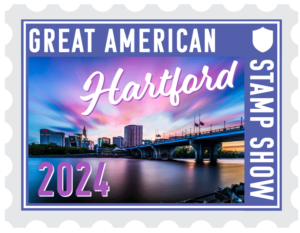 Great American Stamp Show 2023 (“GASS”) is history, but stamp collectors are already getting ready for the next edition, in Hartford, Connecticut.
Great American Stamp Show 2023 (“GASS”) is history, but stamp collectors are already getting ready for the next edition, in Hartford, Connecticut.
Attendance was approximately 2,500 for the 2023 four-day show.
We’ll update this page as we get more details, but here are the basics:
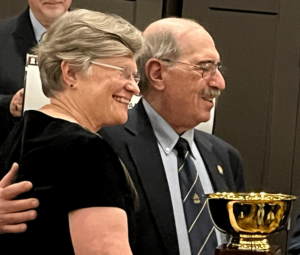 Meanwhile, the Palmares (exhibit winners) for the three exhibitions at GASS 2023 are here, and the list of literature awards is here. On the left, Nick Lombardi was presented with the Champion of Champions award, for the best philatelic exhibit in the previous 12 months, by APS president Cheryl Ganz. It was the 21st time his exhibit had been in the running for this top award but the first time it had won. It was also the first time an exhibit of post-19th century stamps or covers had won the C of C.
Meanwhile, the Palmares (exhibit winners) for the three exhibitions at GASS 2023 are here, and the list of literature awards is here. On the left, Nick Lombardi was presented with the Champion of Champions award, for the best philatelic exhibit in the previous 12 months, by APS president Cheryl Ganz. It was the 21st time his exhibit had been in the running for this top award but the first time it had won. It was also the first time an exhibit of post-19th century stamps or covers had won the C of C.
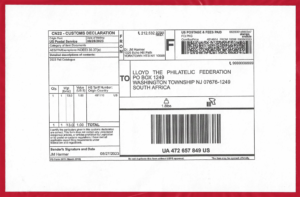 An interesting piece of mail in my box today. At first I wondered who was sending me something that required a customs label. Then I realized it was a U.S. customs declaration! I took another look at the address. (Click on the picture to see a bigger version.)
An interesting piece of mail in my box today. At first I wondered who was sending me something that required a customs label. Then I realized it was a U.S. customs declaration! I took another look at the address. (Click on the picture to see a bigger version.)
Still, not too bad: Despite the extra postage (presumably) paid via the Stamps Endicia system (“FCI” is probably “First Class International”), it made the 40-mile trip — 83 miles if it detoured to the JFK Airport Customs facility — in just a day.
Thank goodnes for ZIP codes!
It was an auction catalogue, by the way.
[from PostNL material] [click on any of the pictures for larger versions]
100 Years of Disney
• Date of issue: 7 September 2023
• Format: sheet of five personalised stamps in five different designs; one personalised stamp with 24-carat gold denomination 1 for post weighing up to 20g with destinations within the Netherlands
• Item number: 830062 (five stamps) and 830047 (stamp with 24-carat gold)
• Illustrations and design: The Walt Disney Company – Benelux
PostNL will release the 100 Years of Disney personalised stamps on 7 September 2023 to mark Disney’s 100th anniversary. The sheet of five stamps stars the Disney characters 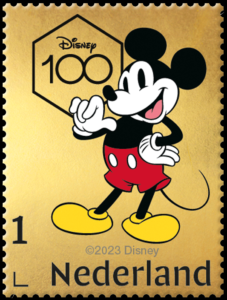 Snow White, Dumbo, Princess Elsa, Simba and Mickey Mouse. The denomination on these stamps is ‘1’, the denomination for items weighing up to 20g with destinations in the Netherlands. The stamps were designed by The Walt Disney Company’s Benelux creative team. A sheet of ten stamps costs €5.05.
Snow White, Dumbo, Princess Elsa, Simba and Mickey Mouse. The denomination on these stamps is ‘1’, the denomination for items weighing up to 20g with destinations in the Netherlands. The stamps were designed by The Walt Disney Company’s Benelux creative team. A sheet of ten stamps costs €5.05.
In addition, PostNL will release a Mickey Mouse stamp with 24-carat gold (shown on the right), in an edition of 1,000 stamps. PostNL will deliver the gold stamp along with a special storage box (shown below; click here) with a certificate of authenticity. The retail price is €50.00.
The special anniversary will be celebrated by Disney in various ways, including new films, festive events, exclusive Disney 100 products and special activities in the theme parks. Brothers Walt and Roy Disney founded The 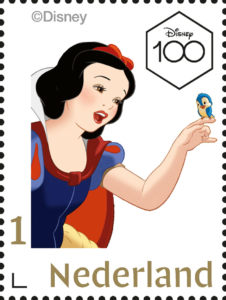 Disney Brothers Studio on 16 October 1923. The company name was later changed, first to Walt Disney Productions and then to The Walt Disney Company. The media group focuses on films, music, media channels, theme parks and consumer products.
Disney Brothers Studio on 16 October 1923. The company name was later changed, first to Walt Disney Productions and then to The Walt Disney Company. The media group focuses on films, music, media channels, theme parks and consumer products.
The Walt Disney Company’s foundation is the production and distribution of successful content, including classic animated films like Snow White, Bambi, The Lion King and – more recently – Frozen, Encanto and Lightyear. The company operates six theme parks worldwide (in California, Florida, Paris, Tokyo, Hong Kong and Shanghai) as well as a cruise line (Disney Cruise Line). The group includes TV channels such as ABC and Disney Channel, streaming channel Disney+, sports channel ESPN and 10 regional TV channels and 71 local radio stations in the US. A separate division deals with consumer products, merchandising and licensing, 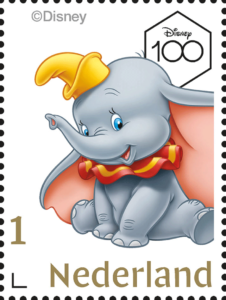 including for children’s books and comics.
including for children’s books and comics.
The Walt Disney Company acquired the rights to Jim Henson’s Muppets in 2004. It acquired Pixar Animation Studios (known for Toy Story and Finding Nemo, among others) in 2006 and Marvel Entertainment (known for Spider-Man, X-Men and The Incredible Hulk, among others) in 2009, followed by Lucasfilm.
The 100 Years of Disney stamps feature five popular Disney characters. Each stamp features the 100 Years of Disney anniversary logo. The main characters on the stamps are from several of Disney’s classic animated films and comics. From left to right are Snow White (from the film Snow White and the Seven Dwarfs), Dumbo (from the film Dumbo), Princess Elsa (from the film Frozen), Simba (from the film The Lion King) and Mickey Mouse (from numerous animated films and comics).
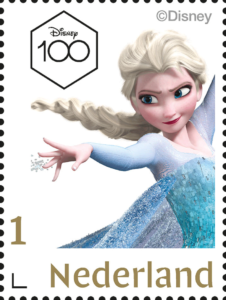 The top sheet edge features a collage of the same images in a pattern composed of triangles, representing the facets of a diamond. The sheet edges of the stamp sheet are platinum in colour, with the typography in white. The stamps with 24-carat gold feature the same drawing of Mickey Mouse against a gold background.
The top sheet edge features a collage of the same images in a pattern composed of triangles, representing the facets of a diamond. The sheet edges of the stamp sheet are platinum in colour, with the typography in white. The stamps with 24-carat gold feature the same drawing of Mickey Mouse against a gold background.
“We’re celebrating our 100th birthday together with our fans,” says Roos van der Wijk, Disney’s Senior Manager Brand Partnerships & XLOB Promotions for Benelux. “There are new films coming out, concerts and all sorts of other events. All sorts of things are also happening in the theme parks, including together with the Make-a-Wish Foundation. We are also launching all kinds of exclusive products as part of 100 Years of Disney. Temporarily and in limited editions.”
Van der Wijk says everyone has a connection to Disney. “The unique storytelling, the  imagination and creativity, the magic and wonder — all of this makes us have that strong connection with audiences of all ages. Whether it’s a product with a Disney character on it or a fond memory of a specific film or character, we all grew up with it.”
imagination and creativity, the magic and wonder — all of this makes us have that strong connection with audiences of all ages. Whether it’s a product with a Disney character on it or a fond memory of a specific film or character, we all grew up with it.”
She says at first, just using Mickey Mouse on the stamps was considered, but instead, the five characters were chosen. “These are Disney icons, the classics that everyone knows. Timeless and with something for everyone, young and old,” Van der Wijk says. “Dumbo and Simba appeal mainly to children, while Snow White and Elsa are real power women. And Mickey Mouse is, of course, everyone’s favourite.”
The characters on the stamps span Disney’s 100-year history. The oldest is Mickey Mouse. Walt Disney came up with him in 1928 for the animated film Plane Crazy. Mickey appears in numerous cartoons, animated films and TV shows and has become a true ambassador of the Disney brand.
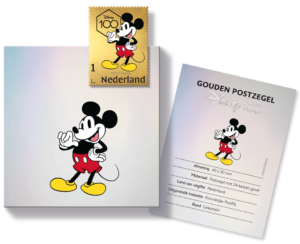 [The box and certificate for the gold stamp is shown on the right.]
[The box and certificate for the gold stamp is shown on the right.]
Snow White is also from an animated Disney film titled Snow White and the Seven Dwarfs. The story in the 1937 film is based on the Grimm brothers’ fairy tale of the same name.
The little elephant Dumbo is from the 1941 animated film of the same name. The story is taken from Dumbo, the Flying Elephant by Helen Aberson. In this 1939 children’s book, a baby elephant learns to fly in the circus.
The lion Simba, son of lion king Mufasa, is the star of the 1994 animated film The Lion King. The great success of this film, set on the African savannah, led to several sequels and a musical, among other things.
Finally, Princess Elsa is one of the main characters from the 2013 animated film Frozen. The film builds on Hans Christian Andersen’s fairy tale The Snow Queen. Frozen shows how Elsa, who possesses magical powers she cannot control, overcomes all kinds of adversities together with her sister Anna.
Technical Details:
Stamp size: 30 x 40mm (WxH)
Sheet size: 170 x 122 mm (WxH)
Paper: normal with phosphor print
Glue: gummed
Printing technique: offset
Printing colours: cyan, magenta, yellow, black and PMS gold
Print run: 5,000 sheets (sheet with five stamps)
1,000 stamps (stamp with 24-carat gold)
Format: sheet of five personalised stamps in five different designs; one personalised stamp with gold
Denomination: denomination 1 for post weighing up to 20g with destinations within the Netherlands
Illustrations and design: The Walt Disney Company – Benelux
Item number: 830062 (sheet with five stamps)
830047 (stamp with 24-carat gold)
 Note: PostNL does not sell directly to collectors in North America. Its website refers to a company called Nordfirm, which says it sells Dutch new issues at face value. The Virtual Stamp Club has no connection to this company.
Note: PostNL does not sell directly to collectors in North America. Its website refers to a company called Nordfirm, which says it sells Dutch new issues at face value. The Virtual Stamp Club has no connection to this company.
[press release] [click on any of the pictures for larger versions]
Royal Mail Celebrates Marmalade-Loving Paddington with a Set of Delightful Special Stamps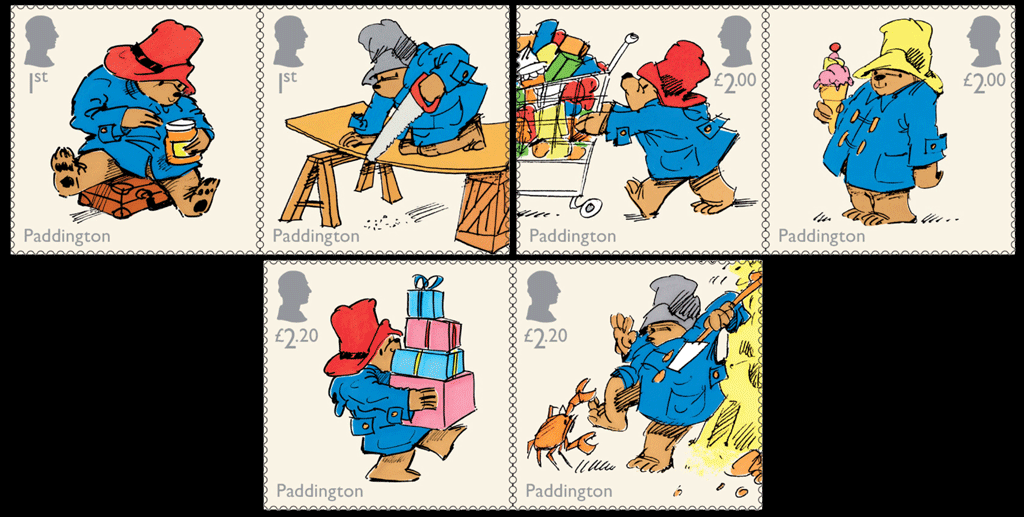 Issue date: 5 September
Issue date: 5 September
 The 10 stamps also mark the 65th anniversary of the publication of A Bear Called Paddington, written by Michael Bond
The 10 stamps also mark the 65th anniversary of the publication of A Bear Called Paddington, written by Michael BondRoyal Mail has revealed images of 10 Special Stamps being issued to celebrate 65 years  of the most beloved marmalade-loving bear – Paddington.
of the most beloved marmalade-loving bear – Paddington.
Six stamps in the main set are taken from Ivor Wood’s strip cartoons of Paddington, originally published in the London Evening News newspaper in the late 1970s.
In 1975, illustrator, animator, and writer Ivor Wood was instrumental in transforming Paddington from a beloved literary character into a star of the small screen. Working with animation company FilmFair, Wood designed and directed the first Paddington television series for the BBC. Four stamps presented in a Miniature Sheet capture moments from this TV series.
David Gold, Director of External Affairs and Policy, Royal Mail, said: “Paddington continues to bring cheer to generations of children worldwide. These delightful stamps will brighten  up the day of anyone receiving mail with a touch of Paddington’s charm.”
up the day of anyone receiving mail with a touch of Paddington’s charm.”
Rachel Clarke, SVP Licensing and Retail UK at The Copyrights Group, said: “Paddington is a real heritage brand with a modern hero and we are delighted to be partnering with Royal Mail to celebrate 65 years since Michael Bond first introduced us to the beloved bear.”
The stamps are available to pre-order at www.royalmail.com/paddington and by telephone on 03457 641 641. A Presentation Pack including all 10 stamps in the set is priced at  £17.70. The stamps go on general sale on 5 September.
£17.70. The stamps go on general sale on 5 September.
About Paddington
For 65 years, British-born writer Michael Bond has delighted readers all over the world with his stories about Paddington, the bear from Peru, famous for his love of marmalade. The kindness and humour in the stories appeal to children and adults alike, ensuring Paddington’s enduring popularity from one generation to the next.
 HarperCollins Children’s books have published Paddington’s adventures continuously since 13th October 1958 when, as William Collins, they first introduced A Bear Called Paddington to the world.
HarperCollins Children’s books have published Paddington’s adventures continuously since 13th October 1958 when, as William Collins, they first introduced A Bear Called Paddington to the world.
Since then, Paddington’s adventures have been adapted several times for television and at the end of 2014 Paddington made his debut onto the big screen, a further film “Paddington 2” followed in 2017 with a third in the works. The movies were produced by STUDIOCANAL, European leader in production,  distribution and international sales of feature films and series, part of CANAL+ Group, major player in the creation and distribution of content worldwide. In 2020, a brand-new Paddington TV series designed for a pre-school audience, “The Adventures of Paddington” launched on Nickelodeon, introducing him to a whole new set of fans.
distribution and international sales of feature films and series, part of CANAL+ Group, major player in the creation and distribution of content worldwide. In 2020, a brand-new Paddington TV series designed for a pre-school audience, “The Adventures of Paddington” launched on Nickelodeon, introducing him to a whole new set of fans.
From VSC: Other products include first day covers of both the set of stamps (£13.40) and the minisheet (£8.10), each available with a choice of two different postmarks, a medal FDC (£19.99), postcards, and various sheets with some or all of the stamps. 